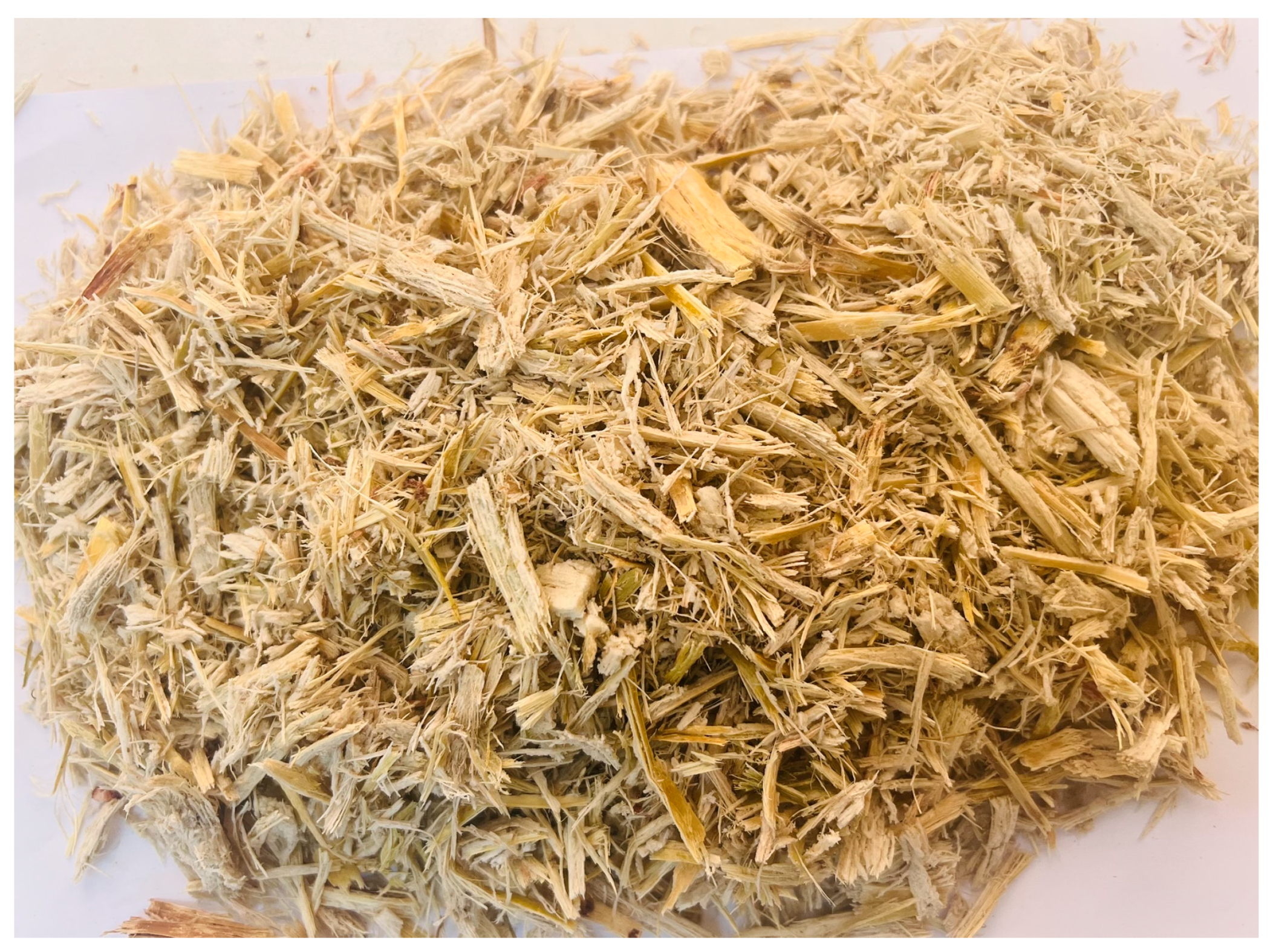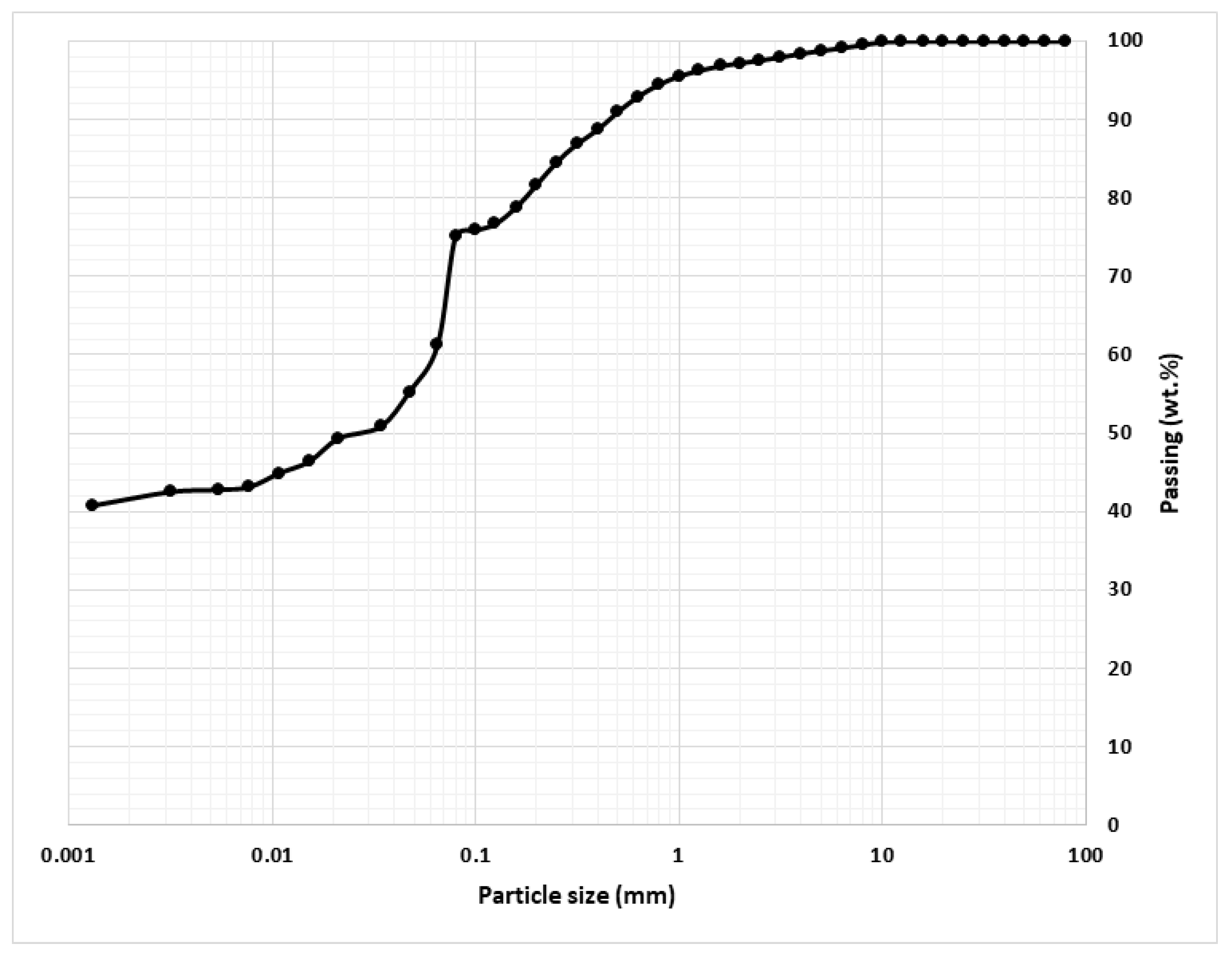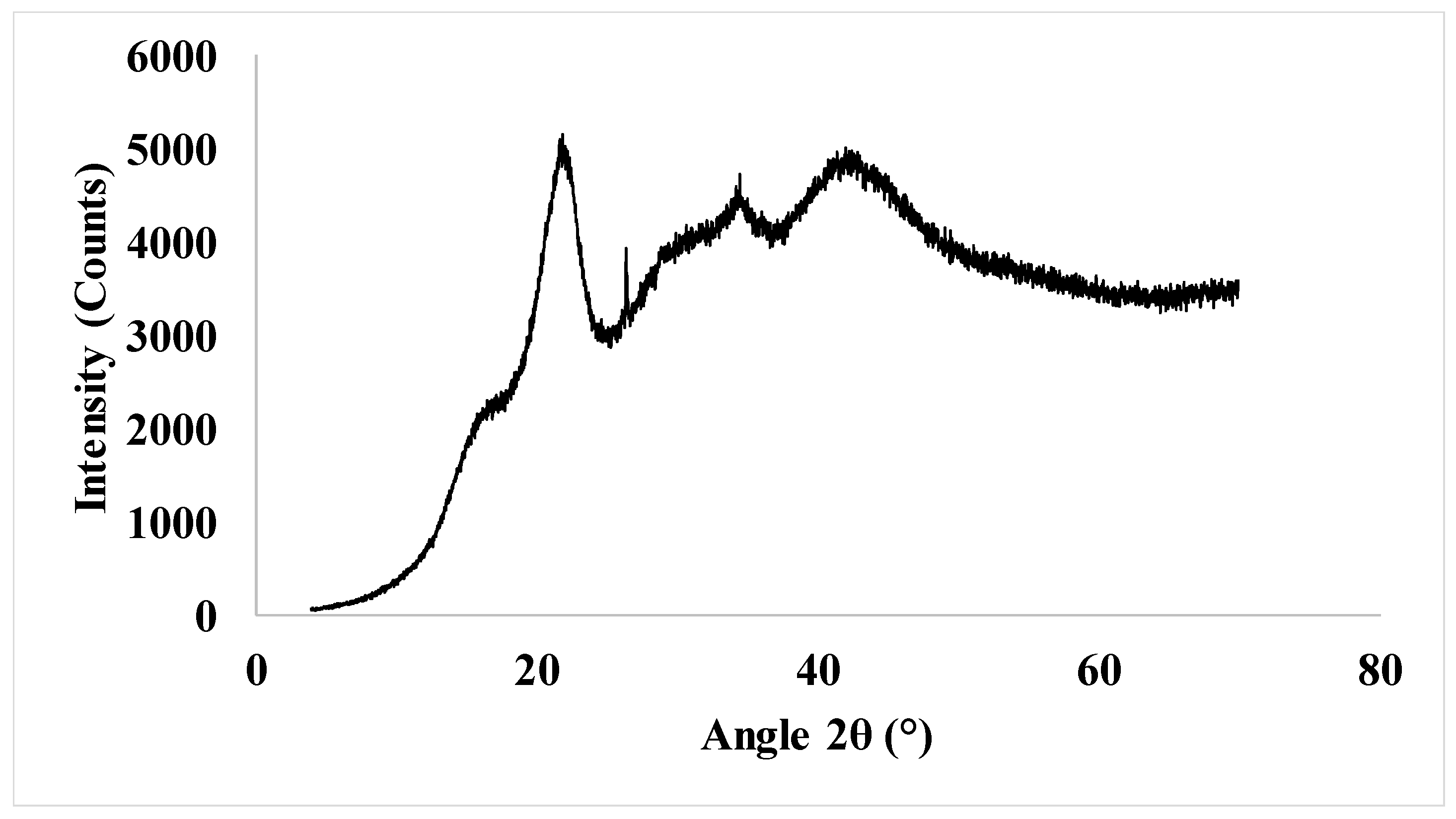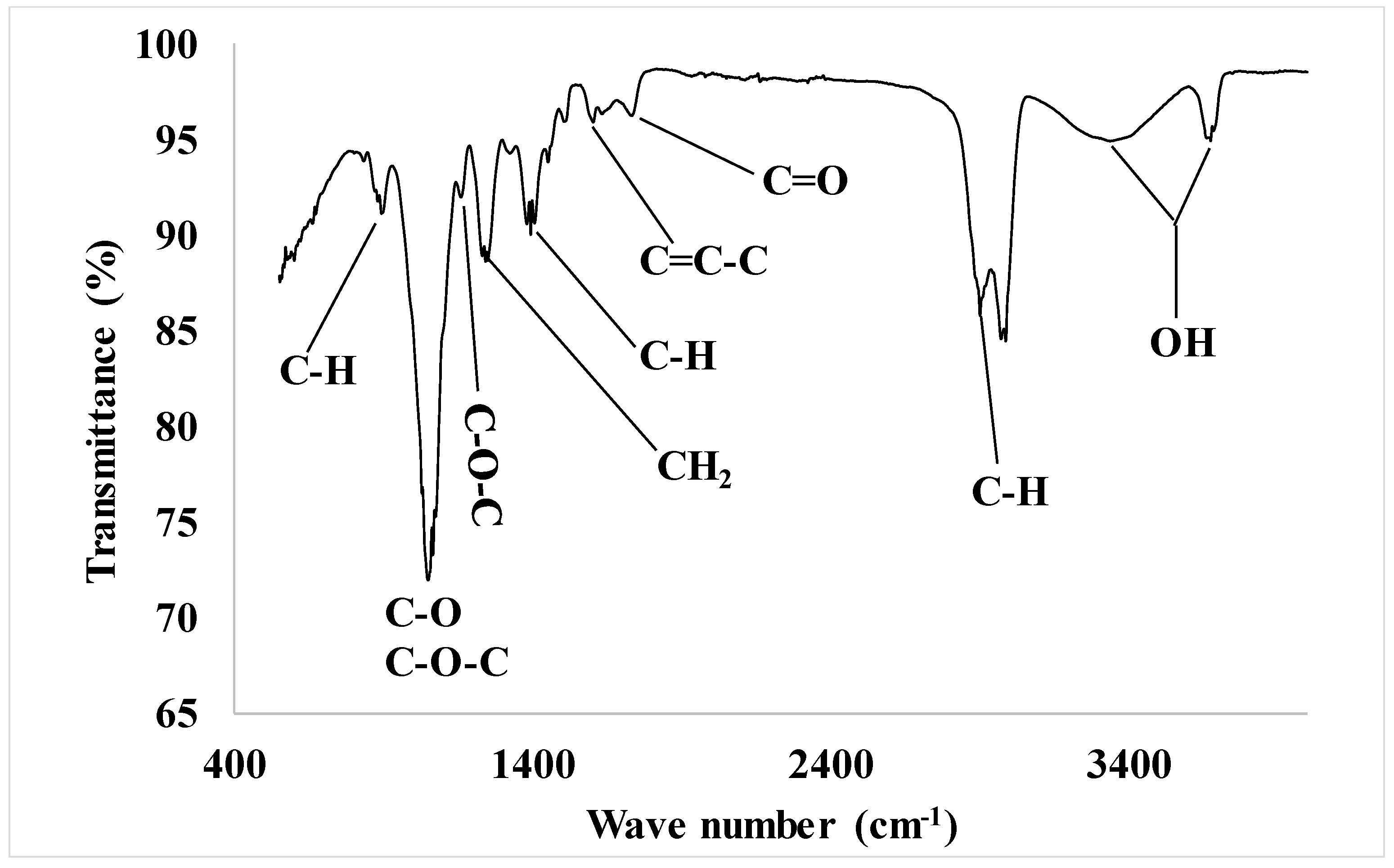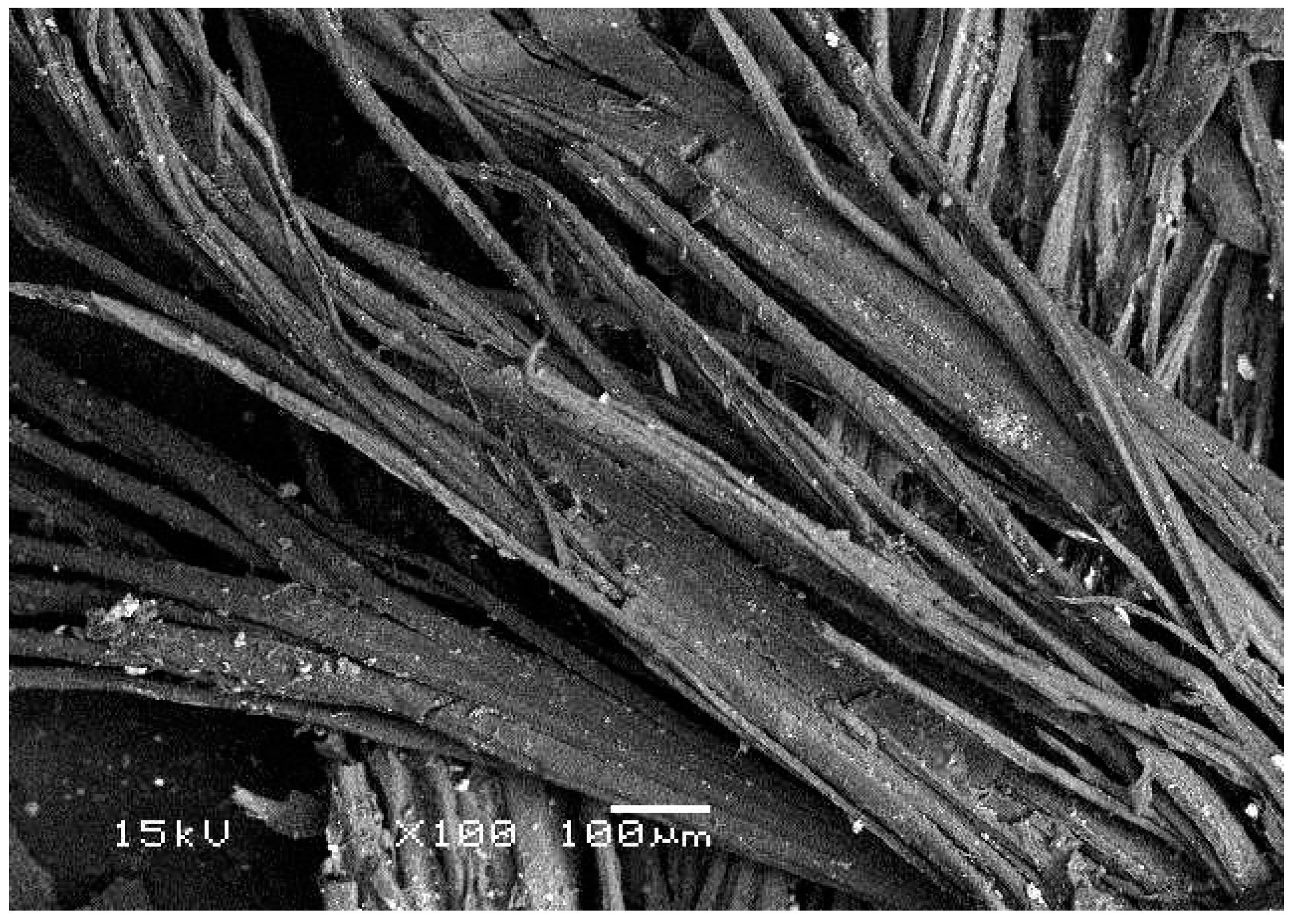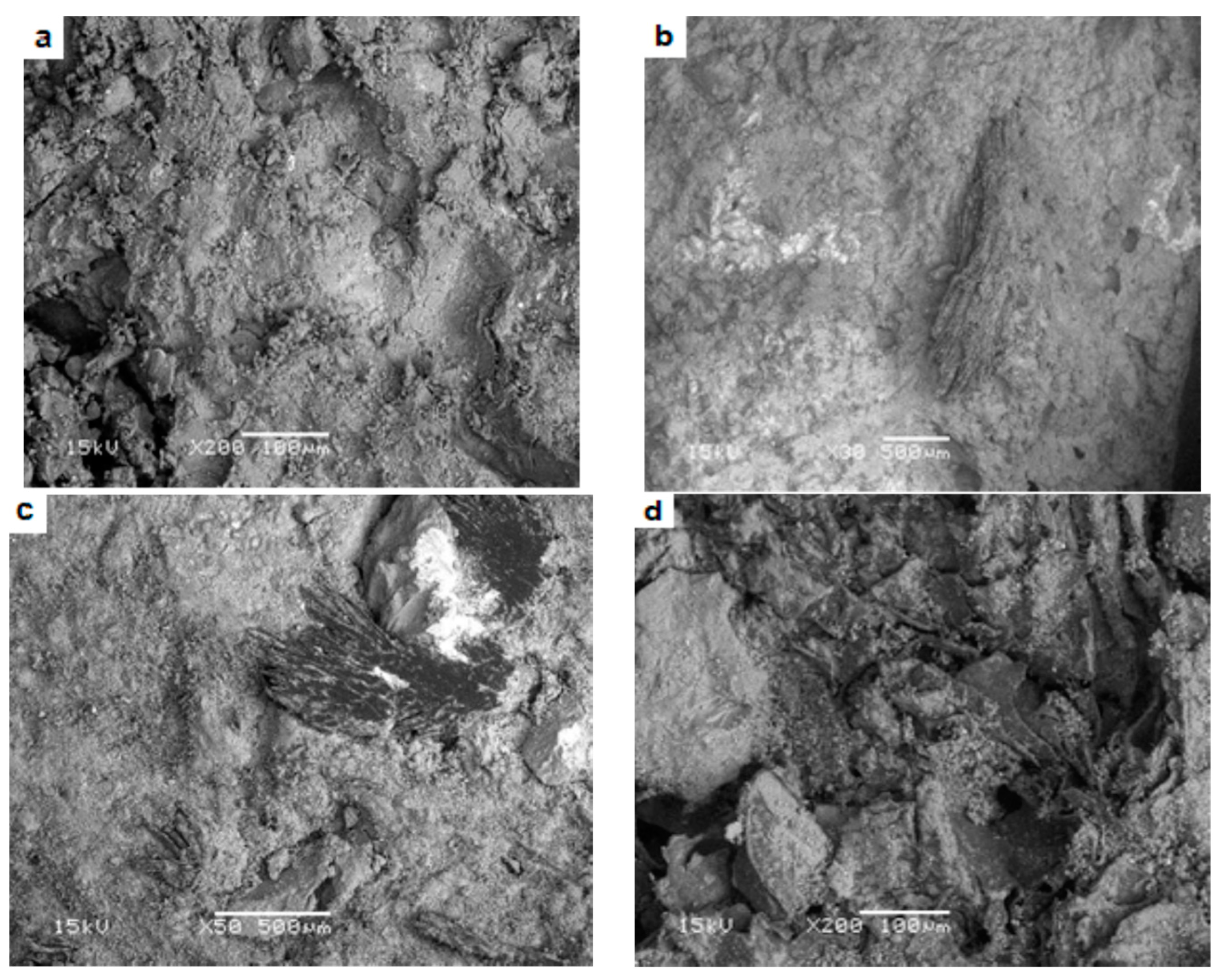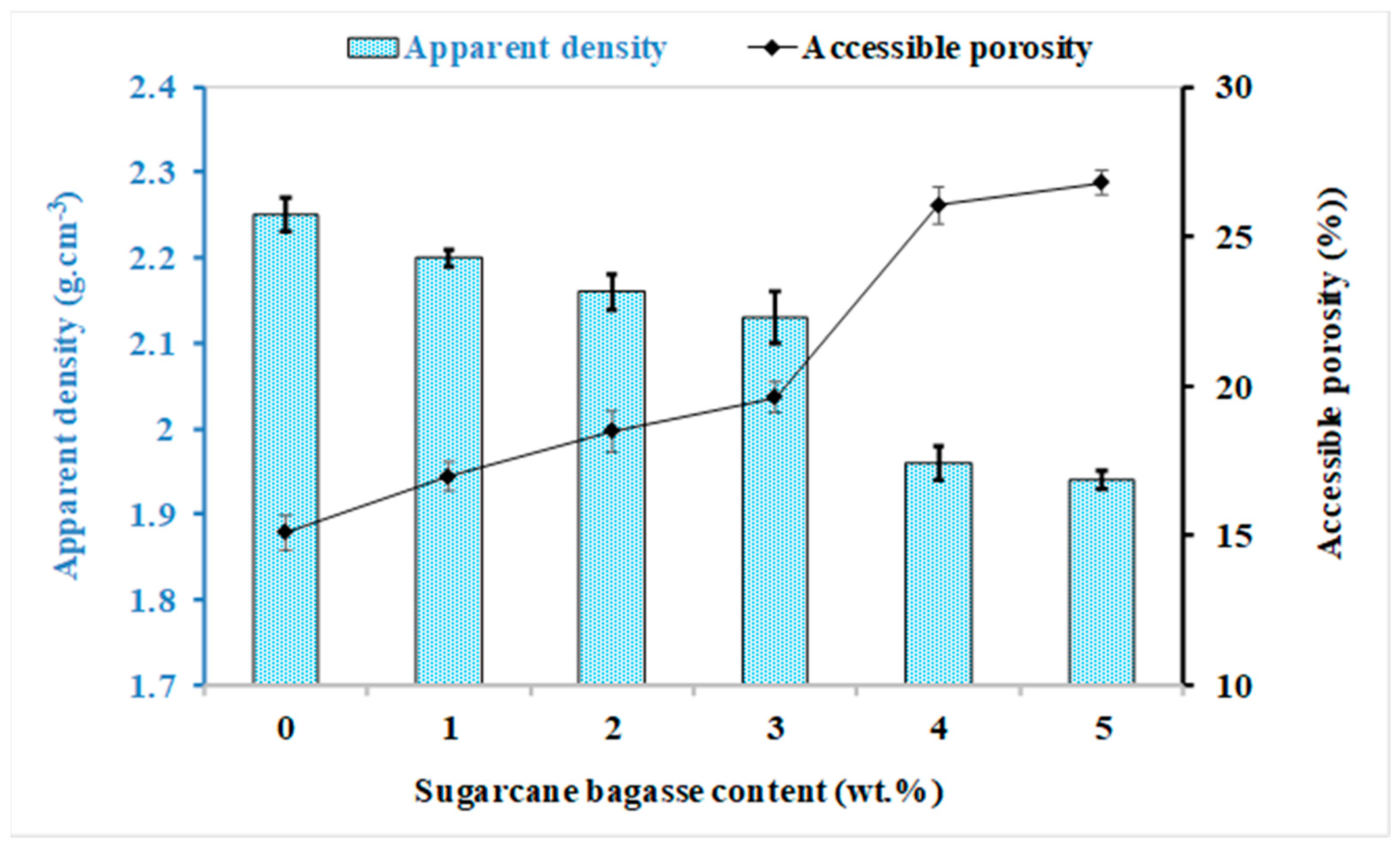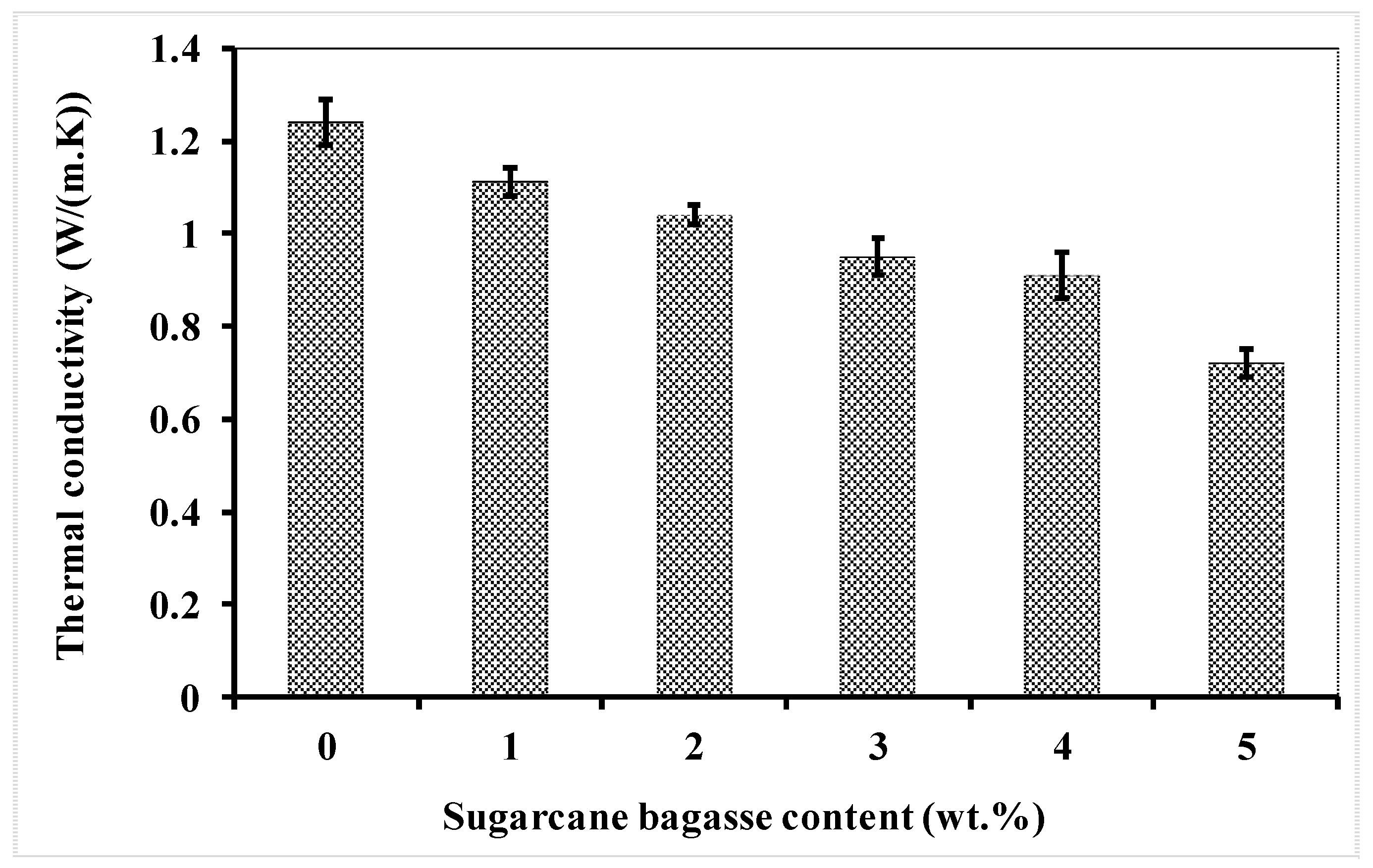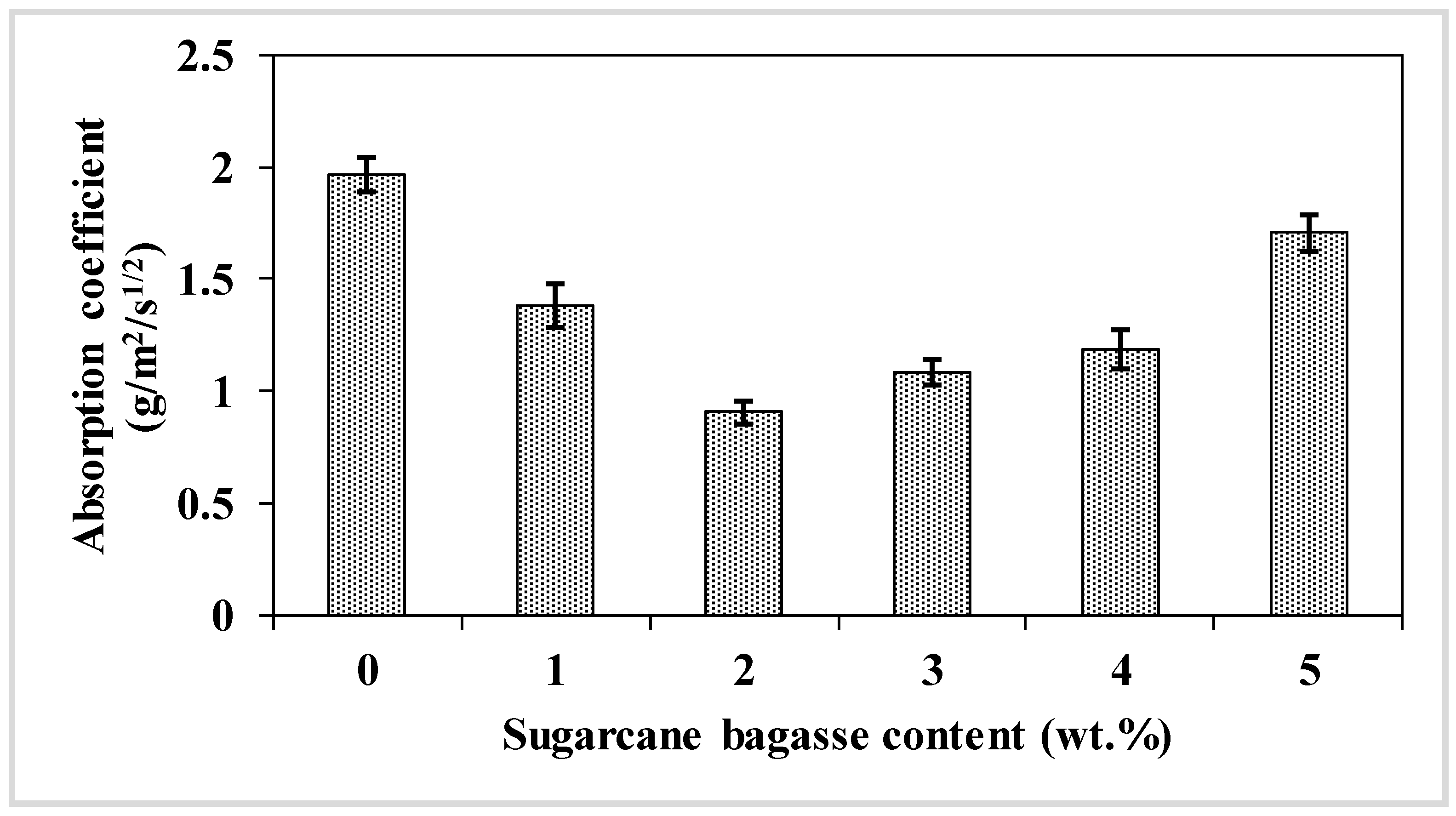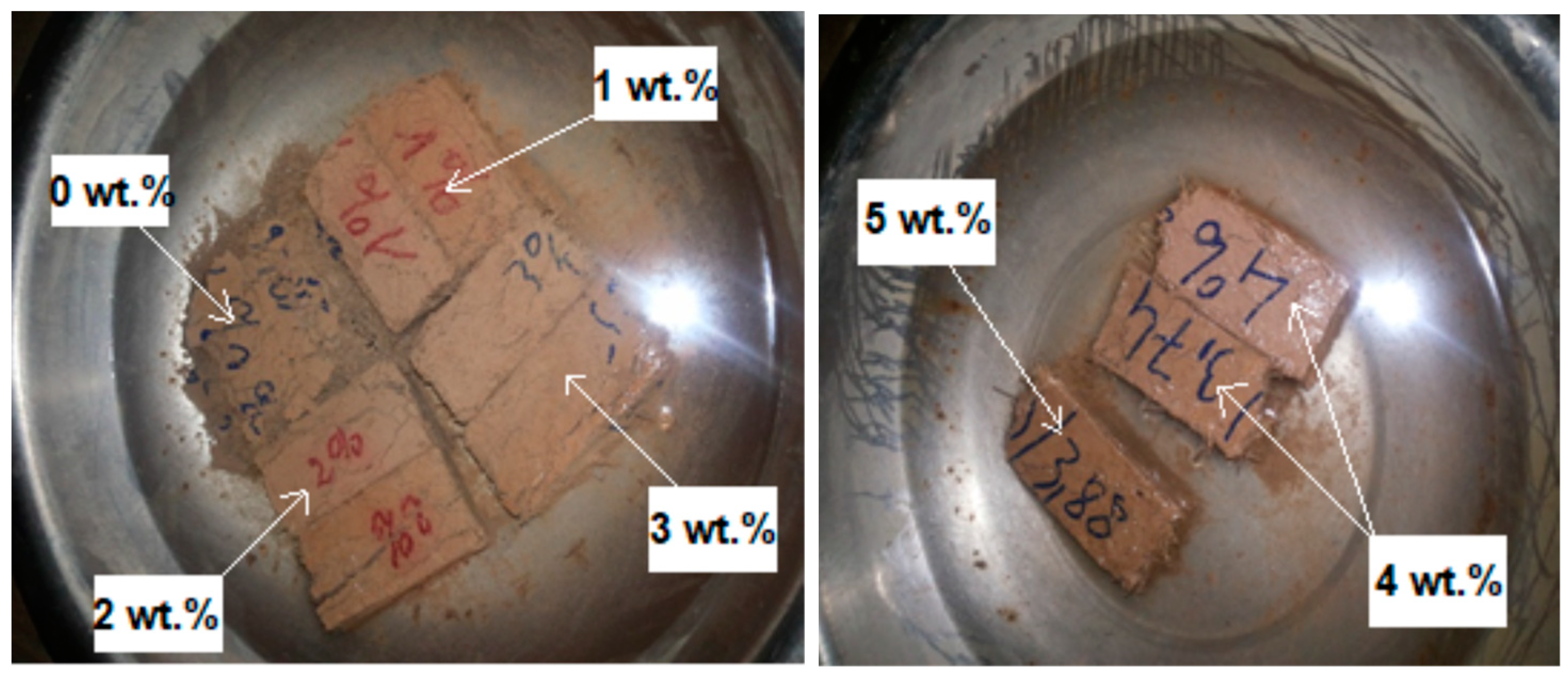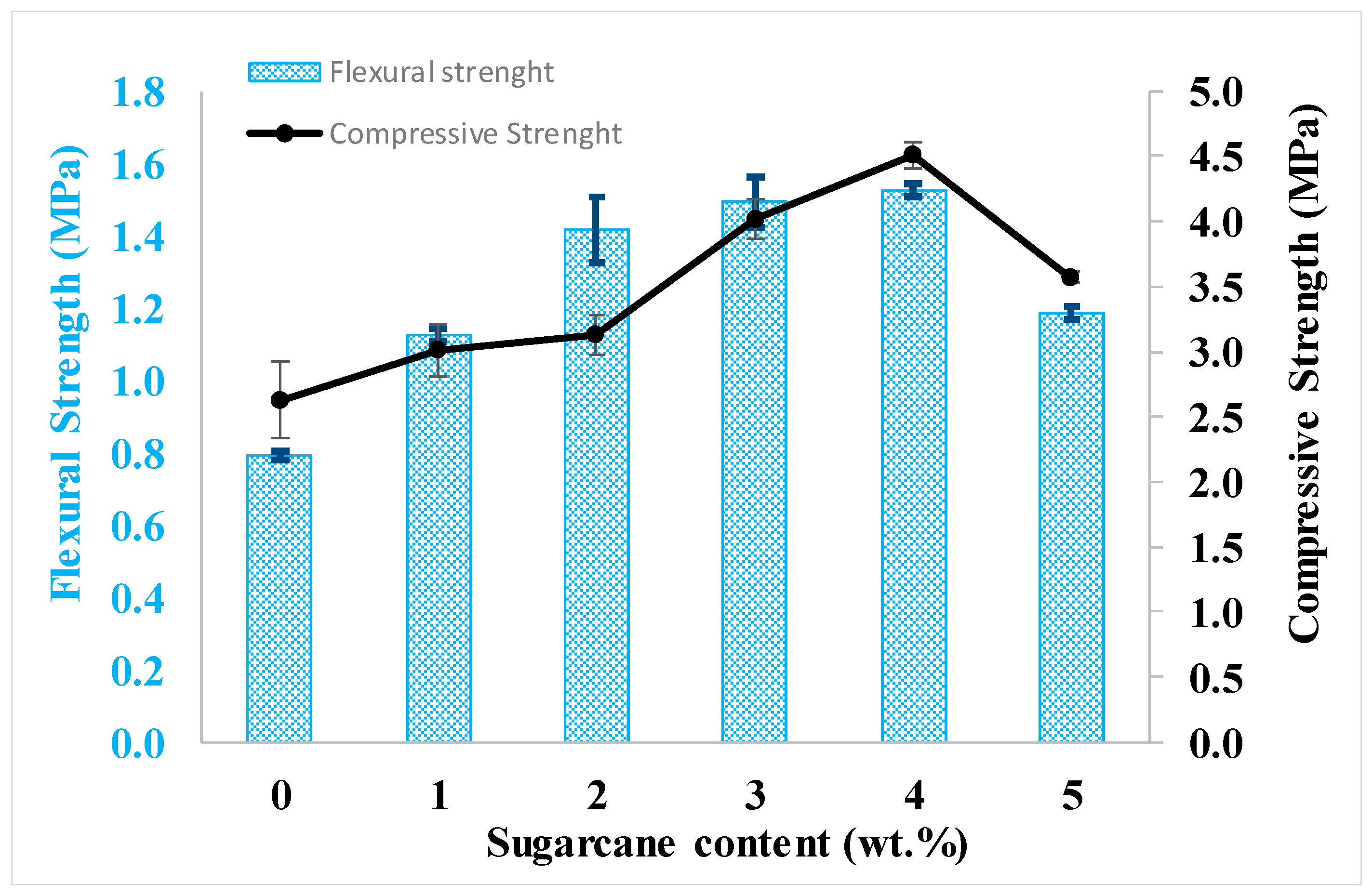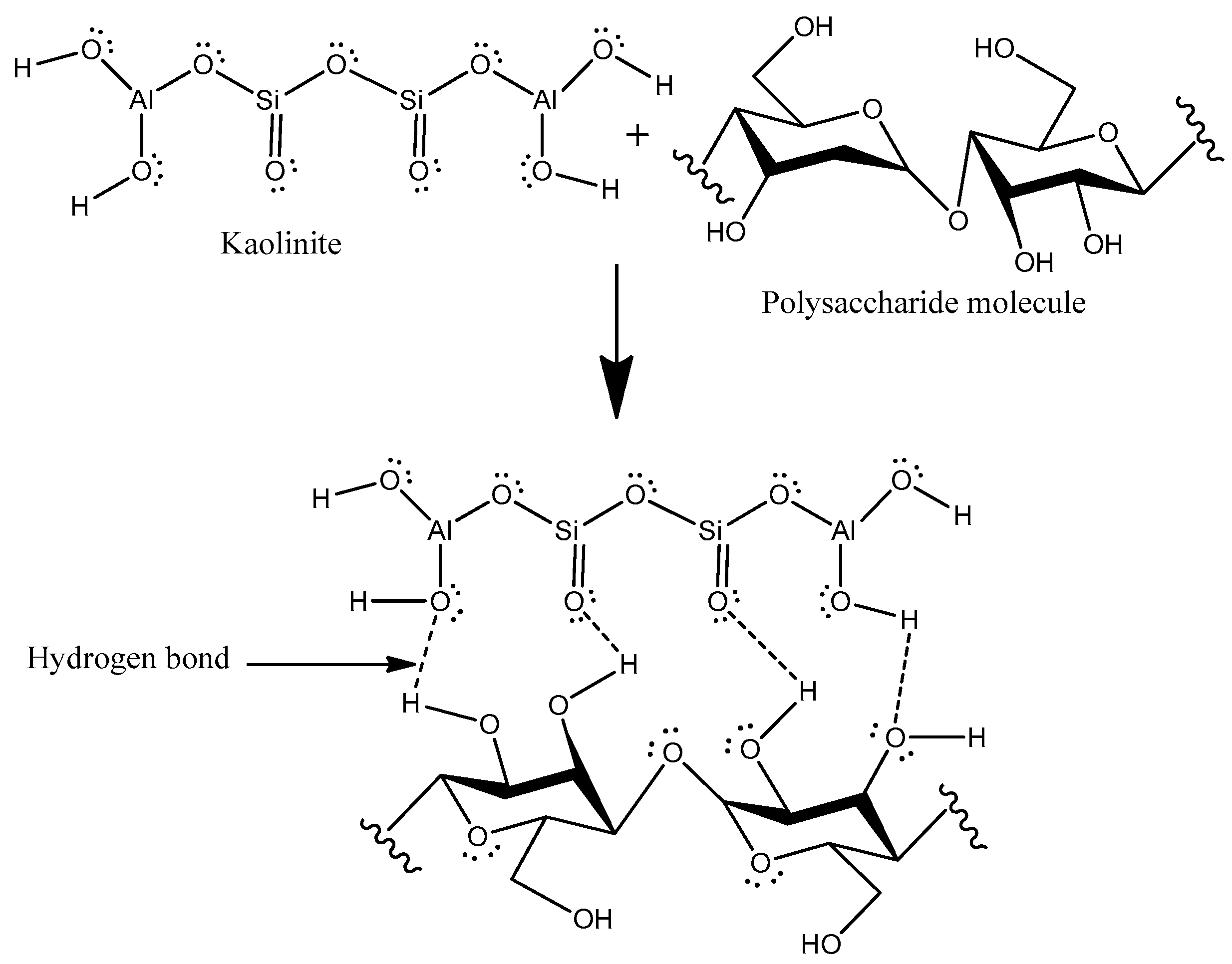1. Introduction
For several decades, the environmental footprint of the construction sector has been increasing significantly, in terms of both global warming and depletion of natural resources. It has thus become necessary to change building habits, in particular by using materials that have a low environmental impact and are renewable, such as earth, or materials coming from a circular economy, such as waste. Among the waste products that are easily reusable in the construction field are agricultural residues, which enable the performance of earth materials to be improved while recycling a plant resource that stores CO2 throughout the life of the material. This article responds to the objective mentioned above by investigating the interest of reusing an agricultural by-product (sugarcane bagasse) in earth bricks (adobes).
Bagasse is a residue resulting from the crushing of sugar cane once the juice has been extracted. It is very often used to produce electricity in thermal power plants. However, this exploitation releases large amounts of carbon dioxide into the natural environment, making it pollution. In order to give ecological and economic importance to sugarcane bagasse, scientific works have been undertaken to convert it into a value-added product and have aroused the interest of a number of researchers. Sun et al. (2004) [
1] have shown that sugarcane bagasse, which contains plant fibres and has a high cellulose content (~45 wt.%), is a good thermal insulator that could be interesting for reuse in construction materials.
Adobes are handmade, moulded masonry elements, manufactured with earth and generally dried in the sun. This technique, still used in non-industrialized countries (developing countries), is very ancient. It was used, for example, to build the city of Shibam in Yemen in the 15th century, and the mosques of Djéné in Mali and Dioulasso-Bâ in Burkina Faso. At present, approximately 30% of the world’s population still live in earthen structures, and the majority of these people live in developing countries, where they represent approximately 50% of the population [
2,
3] and have a low financial income.
It has been observed that non-stabilized adobes generally have low mechanical and water resistance. Although adobes present some advantages, such as negligible environmental impact, social and economic benefits and could constitute alternative materials in building construction industries, “conventional” building materials, such as bricks manufactured with sand–cement mixtures, have come into use to provide solutions to the problems related to non-stabilized adobes. These construction materials offer the best durability for homes, but they are expensive for the populations of the majority of developing countries and their production is responsible for environmental pollution because they require the manufacture of clinker, an important component of cement. For example, the production of cement is responsible for about 10% of greenhouse gas emissions [
4]. Moreover, such building materials do not offer thermal comfort for homes, which is very important, particularly in dry climates. The use of systematic stabilization of earth materials with mineral binders such as cement raises many questions [
5] and sometimes divides the scientific community [
6]. Stabilizing adobes without employing chemical stabilizers could be one solution to improve their mechanical and water resistance and the thermal comfort of housing.
Recent studies of adobes reinforced with plant aggregates (coir, oil palm fibres, sisal fibres, kenaf fibres, barley straw, hemp shiv or corn cob) have shown that the incorporation of these fibres and/or vegetable granules improves some physical properties (mainly the thermal conductivity), mechanical properties and the water resistance of these adobes [
7,
8,
9,
10,
11,
12,
13].
Very few studies on the incorporation of sugarcane bagasse in earth in order to improve the physical and mechanical properties of adobes have been reported in the literature. The work of Corrêa et al., 2014 [
14], showed the influence of the additions of sugarcane and synthetic termite saliva on the mechanical properties of reinforced adobes. This work evaluated their compressive strength and static bending strength. The results showed a positive interaction between the adobe components and the compressive strength, with the improvement rising to 60%. The best composition contained 6 wt.% sugar cane bagasse and 0.2 wt.% synthetic termite saliva, but this study hardly addressed the influence of sugarcane bagasse on the microstructure or the physical and mechanical properties of adobes. The microstructural aspect is very important to understand the chemical mechanism involved in the interaction between sugarcane molecules and the clayey matrix.
Sugarcane bagasse is a by-product obtained after sucrose extraction from the sugarcane plant and could be considered as plant waste. The SN-SOSUCO company, which manufactures sugar in Burkina Faso, produces large amounts of sugarcane bagasse, considered mainly as waste. Only small amounts of this waste are used to produce bio-combustible energy for the company, and animals do not eat sugarcane bagasse because of its high lignin content (average 22 wt.%). Therefore, it will be very important to find new ways to add value to these wastes.
The objectives of this work were to study the effects of the addition of bagasse sugarcane on the physical and mechanical properties of adobes. The first step of this study was the characterization of the raw materials used for the manufacture of adobes (clayey material and sugarcane bagasse). The characteristics measured on the adobes reinforced with sugarcane bagasse were water resistance by immersion, water absorption by capillarity, apparent density, open porosity and flexural and compressive strengths. Moreover, mineralogical characterization was also carried out on the adobes containing the fibres in order to explain the mechanisms involved.
2. Materials and Methods
2.1. Raw Materials
The raw clayey material used for this study came from Louaga, a village located about 24 km north of Ouagadougou.
The sugarcane bagasse came from SN-SOSUCO, a company located at Beregadougou (latitude 10°46′04″ north and longitude 4°43′52″ west), which manufactures sugar. This sugarcane bagasse is considered waste for this company.
Figure 1 is a photo of sugarcane bagasse.
The treatment of sugarcane bagasse fibres was carried out according to the work of Dinu I. (2006) [
15]. This treatment consisted of boiling (~100 °C) the fibres in a mixture of water and 2.5 wt.% sodium carbonate for 90 min. During this treatment, the sodium carbonate in the water created an alkaline medium. This process released the cellulose fibres by solubilizing most of the lignin and hemicelluloses. The dissociation of sodium carbonate in water and under heat was performed according to Equations (1) and (2):
2.2. Procedures
2.2.1. Geotechnical, Chemical and Mineralogical Characterization of Soil Sample
The geotechnical characteristics measured on the raw clayey material were grain size distribution, Atterberg limits and methylene blue value. The grain size distribution of the sample studied was analysed using two complementary techniques. The coarser fraction (≥80 μm) distribution was assessed by wet sieving, whereas the finer fraction (<80 μm) was determined by means of a sedimentation method using Stocke’s law [
16,
17]. The Atterberg limits and the methylene blue value of the soil were obtained following AFNOR NF P 94-051 (1993) [
18] and AFNOR NF P 94-068 (1998) [
19], respectively.
A sample of the raw material was crushed into particles smaller than 80 µm and melted with lithium tetraborate (Li2B4O7) to form a glass bead. The glass bead was dissolved in nitric acid, and the solution obtained was analysed by inductively coupled plasma-optical emission spectrometry (ICP-OES) to determine its chemical composition. The loss on ignition was calculated after sample calcination at 1000 °C.
To assess its mineralogical composition, X-ray diffraction (XRD), differential scanning calorimetry (DSC), thermal gravimetric analysis (TGA) and infrared spectrometry (IR) were used on the soil sample. XRD experiments were performed using a Brüker D8 Advance X-ray Diffractometer equipped with a copper anticathode Kα (λ = 1.54 Å) monochromator. DSC-TGA was carried out on a sample crushed to size of <80 μm and heated to 1000 °C at a constant rate of 10 °C/min using a Netzsch SATA 449 F3 Jupiter apparatus. Infrared spectrometry was carried out on an attenuated total reflectance–Fourier transform infrared spectrometer (ATR-FTIR Frontier, 4000–550 cm−1, diamond crystal—Perkin Elmer).
2.2.2. Density and Microstructure of Sugarcane Bagasse
Bulk density was determined using 50 cm
3 capacity pycnometer and a 10
−4 precision analytical balance. Ethanol was used as the solvent according to Equation (3):
with
= 0.8051 g/cm
3.
= mass of the empty 50 cm3 pycnometer.
= mass of the pycnometer containing 1 g of sugarcane bagasse fibre.
= mass of pycnometer containing 1 g of sugarcane bagasse fibre and filled to the gauge line with ethanol.
= mass of pycnometer filled only with ethanol up to the gauge line.
The microstructure of the sugarcane bagasse was investigated using scanning electron microscopy (SEM) (JEOL JSM6380-LV microscope) after carbon evaporation at the surface of the sample. Observations were made in secondary electron imaging (SEI) mode. The same technique was used to assess the microstructure of plain adobes and those reinforced by sugarcane bagasse.
2.2.3. Manufacture of Adobe
The clayey soil from Louaga used to manufacture adobes was crushed to obtain particles with sizes <5 mm. The adobes were manufactured using a mixture of soil and 1, 2, 3, 4 or 5 wt.% sugarcane bagasse.
The soil was mixed for about twenty minutes with 34 wt.% water in relation to the dry weight of the soil in order to obtain a homogeneous mixture with good plasticity for moulding the adobes. The water content (w (%)) was calculated using the Atterberg limits by applying Equation (4) [
20]:
The soil was mixed for twenty minutes with a suitable amount of water to obtain a homogeneous mixture, according to the procedure used by Ouedraogo et al. (2019) [
20]. The mixture was put into 4 × 4 × 16 cm
3 prismatic moulds in two layers, and a manual compaction of 30 shocks was applied for each layer. The samples were then dried for 24 h in the shade (30 ± 5 °C) and exposed in the open air before demoulding. The manufactured adobes were dried again in the shade for 21 days before the characterization tests were performed [
13,
21,
22].
Table 1 gives the average weight of the various samples.
2.2.4. Physical and Mechanical Characterization of Adobes
In order to assess the resistance of adobes to water, water absorption was tested by capillarity and by immersion on the different adobe formulations.
The test to determine water absorption by the capillarity coefficient (A) was performed on prismatic samples (4 × 4 × 16 cm
3) dried in an oven at 105 °C for 24 h [
23]. After drying, the test was performed at room temperature (~30 °C). The bottom surfaces of the test specimens were protected with filter paper to avoid particle loss during this test. The test specimens were placed in a beaker with the protected side in contact with a water-soaked bed (cloth). The specimen was weighed at 1, 4, 9, 16, 36, 49 and 64 min to measure the amount of water absorbed. The water absorption coefficient by capillarity, A, was estimated using the following equation [
20,
24].
In Equation (5), m0 is the weight of the dry sample, m1 is the weight of sample soaked in water for a duration of t seconds and S is the base surface area (4 × 4 cm2) of the sample.
The immersion test was performed for 96 h to observe the long-term water resistance of the adobes. The test consisted of saturating the specimen by absorption of water through its pores: the specimen was totally immersed in water, and the increase of its mass was determined by simple weighing [
25].
Apparent density was measured on prismatic samples according to the hydrostatic procedure used by Ouédraogo et al. (2017; 2019) [
13,
20].
Accessible porosity was measured using an AutoPore IV 9500 V1.10 mercury porosimeter on dried samples. The thermal conductivity parameter (λ) was evaluated on reference and sugarcane-bagasse-reinforced adobes. The measurements were performed using a hot wire probe, which is a heating resistor with a sensor measuring temperature in a transient state. The probe was placed between two adobe samples that were made as smooth as possible to avoid contact with the air. The apparatus used for the measurements was a NEOTIM-FP2C thermal conductometer.
Compressive and flexural strengths were measured using a Controlab hydraulic press equipped with a 200 kN capacity load cell. The tests were run at a displacement rate of 0.5 mm/min according to AFNOR NF P 15-451 [
26].
3. Results and Discussion
3.1. Geotechnical, Chemical and Mineralogical Characterization of Louaga Soil
Figure 2 presents the particle size distribution of a sample of Louaga soil. This curve shows that the soil was rich in fine grains (75 wt.% of the particles were below 80 μm) with the clay fraction (<2 μm) equal to 42 wt.%. The Atterberg limits were 45% for the liquid limit (w
L), 23% for the plastic limit (w
P) and 22% for the plasticity index (IP). The methylene blue value was 2.8/100 g. As this value is between 2.5 and 6/100 g, the sample could be considered as a clayey fine sand [
27]. According to Dao et al. (2018) [
28] and considering the Atterberg limit values, the Louaga sample seems to be suitable for the manufacture of adobes.
The chemical composition of Louaga clay soil is given in
Table 2.
Louaga clay is rich in silica and alumina oxides with a small amount of iron oxide.
The XRD pattern of the soil is presented in
Figure 3. This pattern shows the presence of quartz (SiO
2), kaolinite (Al
2(Si
2O
5)(OH)
4) and goethite (α-FeO(OH)) and confirms the chemical composition.
The mineralogical characterization of the Louaga sample was completed by DSC-TGA. The DSC-TGA curves (
Figure 4) show an endothermic peak at around 100 °C followed by a mass loss of 0.4 wt.% linked to the dehydration of the sample. The peak around 250 °C corresponding to a mass loss of 1.8 wt.% was due to the dehydroxylation of goethite and its transformation into hematite (event 1). The large endothermic peak between 330 and 570 °C with a mass loss of 5.4 wt.% was due to the dehydroxylation of kaolinite and its transformation to metakaolinite (event 2). This peak appeared at low temperature (less than 600 °C) because of the low crystallinity of the kaolinite, which was disordered [
27]. The endothermic peak at 577 °C was linked to the transformation of quartz α into quartz β (event 3), and the last exothermic peak, at 965 °C, was due to the structural reorganization of metakaolinite (event 4).
The mineralogical composition of crystallized minerals of the sample was calculated by using the qualitative mineralogical composition and the chemical composition according to Equation (6).
For chemical element a, the following relation was used to calculate the amount T (a) of oxide (wt.%) with Mi is the amount (in wt.%) of mineral i in the material under study. In the Equation (6), Pi (a) is the proportion of the element a in the mineral i. The calculation shows that the Louaga sample was also composed of quartz (47 wt.%), kaolinite (44 wt.%) and goethite (5 wt.%).
3.2. Physical, Mineralogical, Biochemical and Microstructural Characterization of Sugarcane Bagasse
The average value of the density measured on three samples of the sugarcane bagasse using a pycnometer was equal to 0.717 g/cm
3. This density is lower than that of kenaf, sisal, coco and lechuguilla fibres [
13,
29,
30].
The XRD pattern of the crushed sugarcane bagasse is presented in
Figure 5.
This diffractogram shows that sugarcane bagasse has mainly cellulose as its crystallized phase. It crystallizes in a triclinic system and is well crystallized. The crystalline index of cellulose (Ic) was evaluated with Segal’s method by using Equation (7):
where I
002 is the intensity of the XRD peak at 2 θ = 22°, and I
am is the peak at 2 θ = 18° [
31]. The estimated value was 56. The difference with the natural cellulose molecule crystallinity index, close to 100, could be due to the presence of amorphous molecules (significant amorphous halo observable on the XRD pattern) such as hemicelluloses and lignin in sugarcane bagasse, which contributed to the reduction of the crystalline index. However, this value is higher than that of kenaf fibres [
21]. This could be due to the difference of cellulose crystallinity in these two fibres. As shown, the cellulose of sugarcane bagasse is well crystallized.
To complete the mineralogical characterization of sugarcane bagasse, its infrared spectrum was obtained using a crushed sample. The spectrum of the sugarcane bagasse sample is presented in
Figure 6.
This spectrum shows the vibrations of OH groups of cellulose, aliphatic C-H, C=O of the carboxyl groups contained in the hemicelluloses, C=C-C of the aromatic ring structures, the deformation of the acetyl groups (xylans) of lignin and the antisymmetric elongation of C-O-C from cellulose and hemicelluloses [
32].
According to Godin et al. (2010) [
33], sugarcane bagasse is composed of cellulose (40.1 ± 6.7) wt.%, hemicelluloses (26.3 ± 6.3) wt.% and lignin (17.9 ± 6.8) wt.%. The cellulose content of this residue is much lower than that of most natural fibres, such as kenaf, flax, hemp, jute, ramie, sisal, banana, cotton and rice husk, but its lignin content is much higher [
21].
The SEM micrograph of sugarcane bagasse (
Figure 7) shows that it presents a morphological heterogeneity made of wax filaments, which are linked together. It presents also the rough surface favorable to the good adhesion with the clayey matrix. They are arranged longitudinally with more or less parallelism, and spaces are also present between them, which can retain fine clay particles, thus increasing the adhesion and consequently the mechanical resistance of admixed adobes.
3.3. Microstructure of Adobes Reinforced by Sugarcane Bagasse
SEM micrographs of the fractured surfaces of the adobes are presented in
Figure 8a–d. The micrograph of the adobe without sugarcane bagasse (
Figure 8a) shows a heterogeneous microstructure with cracks and large pores. The adobes reinforced with 1 to 4 wt.% of sugarcane bagasse show homogeneous microstructure when the sugarcane bagasse content is increased (
Figure 8b,c). Small sized pores can be observed but no cracks. It can be concluded that the incorporation of sugarcane bagasse in a clayey matrix limits crack propagation in adobes. This is due to the good adhesion of sugarcane bagasse to the clayey matrix because of the rough surface of its fibres. When the sugarcane bagasse content reaches 5 wt.% (
Figure 8d), the microstructure of the adobe becomes heterogeneous, with cracks and large pores, and in some zones, sugarcane bagasse is distributed in the form of packages.
3.4. Physical and Mechanical Characteristics of Adobes
3.4.1. Physical Characteristics of Adobes
The apparent density, accessible porosity (
Figure 9) and thermal conductivity (
Figure 10) curves of adobes reinforced with and without sugarcane bagasse were investigated.
With the addition of sugarcane bagasse, the apparent density decreases and the accessible porosity increases. The decrease in apparent density with sugarcane additions is due to the replacement of some soil particles in the clay matrix with sugarcane bagasse, which is less dense than the soil particles. Thus, the sugarcane bagasse occupies a considerable volume, and this contributes to the reduction of apparent density. With the addition of sugarcane bagasse (rich in plant fibres) to the clayey matrix, densification of the fibres can occur on the surface, creating accessible pores in different areas of the reinforced adobes. There is a good correlation between these two parameters. The same results have been reported by Ouedraogo et al. (2017; 2019) [
13,
20] on adobes reinforced with kenaf fibres and fonio straw.
The thermal conductivity (λ) of adobes amended by sugarcane bagasse decreases as the amount of bagasse in the clayey matrix rises. The decrease is explained by two combined effects: the increase of porosity and the presence of vegetable fibres in the clayey matrix. In fact, sugarcane bagasse, rich in vegetable fibres, contains a large amount of cellulose. This molecule helps to decrease thermal conductivity [
10,
13,
20]. There is a correlation between porosity and thermal conductivity, the latter decreasing when the porosity increases because of the presence of air cavities [
13,
20]. The low thermal conductivity of adobes amended by sugarcane bagasse is important for dry tropical climates. This result means that significant savings can be made in energy linked to air conditioning and ventilation, which is a major problem for developing countries and particularly for dry tropical countries such as Burkina Faso.
The hydric behaviour of these bio-sourced composites is an important aspect for their acceptability in building construction. The effect of the sugarcane bagasse on water absorption in adobes is shown in
Figure 11.
The coefficient of water absorption by capillarity in adobes decreases until sugarcane bagasse additions reach 2 wt.%. This decrease is due to the homogeneous microstructure of adobes reinforced by sugarcane bagasse, with few pores. Beyond 2 wt.% of sugarcane bagasse, the absorption coefficient increases due to the packing of the sugarcane bagasse in the clay matrix. At this sugarcane bagasse content, the hydrophilic effect of the hemicelluloses contained in the bagasse can be observed, and the capillary water absorption in the adobe composite thus increases.
Pictures of adobes immersed in water for 96 h are presented in
Figure 12.
Adobes without sugarcane bagasse did not resist water and were completely destroyed after less than 2 h. The stabilized adobes resisted water immersion and this resistance increased with sugarcane bagasse additions. It was mainly due to good cohesion between the clayey matrix and sugarcane bagasse as a result of the formation of a large number of hydrogen bonds between the free doublets of oxygen and the hydrogen of the clay mineral (kaolinite) and the sugarcane bagasse (cellulose, lignin, hemicelluloses) [
13,
20,
34]. Moreover, the presence of solubilized sucrose in the clayey matrix contributed to the increase in the water resistance of adobes due to the linking of isolated particles of soil by solubilized sucrose (polysaccharides). Polysaccharides (
Figure 13) are long chains of simple sugars, each link of which, represented by a hexagon, is formed by a loop of six carbon atoms, often carrying an oxygen atom and a hydrogen atom. Polysaccharides consolidate the soil by forming microscopic armatures between the clay particles. Long chains of complex sugars are able to link several mineral particles together, creating a network of sorts. In addition, when in contact with water, polysaccharides generally form gels, modifying the consistency of the mortar in its fresh state [
35].
3.4.2. Compressive and Flexural Strength of Adobes
The compressive and flexural strengths of adobes reinforced with sugarcane bagasse are presented in
Figure 14.
The compressive strength of adobes increases with sugarcane bagasse additions up to 4 wt.% and decreases for higher sugarcane bagasse contents. This result can be explained by the good adhesion of sugarcane bagasse to the clay matrix. Firstly, as seen on SEM micrographs (
Figure 7), sugarcane bagasse wax filaments have spaces between them that could improve their adhesion to the clayey matrix. This good adhesion with the clayey matrix could also be due to the sugarcane bagasse’s rough surface. This good adhesion could also be due to the formation of numerous hydrogen links between the mineral kaolinite (hydrogen atoms of hydroxide groups) and sugarcane bagasse organic molecules: cellulose, hemicelluloses and lignin (which has many oxygen atoms with free electronic doublets) [
13,
19,
33]. Finally, as mentioned previously concerning the good resistance to water of adobes reinforced with sugarcane bagasse, this agricultural waste is rich in solubilized sucrose that will act as glue with the clay matrix.
Moreover, the presence of these fibres inhibits crack propagation in adobes and thus improves the compressive strength. This result is in good agreement with SEM micrographs of the adobes. For sugarcane bagasse amounts higher than 4 wt.%, according to SEM micrographs (
Figure 8d), sugarcane bagasse may be distributed in packets. This distribution of fibres in the clayey matrix creates more large pores and therefore contributes to the decrease of compressive strength.
The evolution of flexural strength according to the sugarcane bagasse content is the same as that of compressive strength. The improvement of such mechanical characteristics is mainly due to the high tensile strength of sugarcane bagasse, provided by the crystalline cellulose molecules it contains. The increase in flexural strength is also due to the presence of an acceptable amount of lignin in sugarcane bagasse, which brings stiffness to the fibres. Moreover, this characteristic is improved by the good adhesion of sugarcane bagasse with the clayey matrix. The decrease in flexural strength for high fibre content is due to poor distribution of the fibres in the form of packages in certain areas of adobes. This induces a heterogeneous microstructure with increased porosity.
The magnitudes of the compressive and flexural strengths of adobes are globally doubled between adobes without sugarcane bagasse and those containing 4 wt.% of fibres, which seems to be the optimum content. In studies on kenaf [
13] and fonio straw [
19], the optimum content of such fibres was found to be equal to 1 wt.%. Considering the small amount of cellulose in sugarcane bagasse, compressive strength and, particularly, flexural strength should decrease. As adhesion of fibres to the clayey matrix is mainly responsible for the improvement in mechanical properties, the best mechanical properties of adobes could be explained by the greater surface roughness of sugarcane bagasse when compared to kenaf fibres and fonio straw. Moreover, the increase of mechanical properties could be due to the physical and chemical properties of sucrose remaining in the sugarcane bagasse. Like cellulose, hemicelluloses and lignin molecules, sucrose molecules also establish hydrogen links with soil particles, mainly kaolinite. The composite materials obtained are more compact; therefore, their mechanical properties are improved. Moreover, solubilized sucrose behaves as glue in the clay matrix and thus links isolated soil particles, decreasing adobe porosity and leading to an improvement in mechanical properties. The increase in the mechanical properties of adobes reinforced by sugarcane bagasse could be due to the binding property of sucrose, which contributes to the linking of isolated particles.
The formation of hydrogen bonds between the clay particles (represented by kaolinite) and the residual sugar of the sugar cane bagasse (represented by polysaccharide) is illustrated in
Figure 15.
4. Conclusions
This article deals with the reinforcement of earth bricks (adobes) by the addition of bagasse, an agricultural waste product from sugarcane cultivation. After characterization of the raw materials (Louaga clay and sugarcane bagasse) from the physical, chemical and mineralogical points of view, the manufacture and properties of adobes incorporating up to 5 wt.% of sugarcane bagasse have been described.
Chemical and mineralogical characterizations of the Louaga soil showed that it contained quartz (47 wt.%), kaolinite (44 wt.%) and goethite (5 wt.%), which corresponds to the classical mineralogical composition of a laterite. XRD and IR spectrometry of sugarcane bagasse showed that the bagasse was rich in cellulose, hemicelluloses and lignin with traces of sucrose. Morphological studies showed the surface of bagasse fibres to be rough, which is an advantage that enables these fibres to improve their adhesion with soil particles in adobes.
The addition of bagasse to adobes greatly improves the physical and mechanical properties of the adobes. Up to 4 wt.% addition, the flexural and compressive strengths increase proportionally to the amount of bagasse added. This improvement in mechanical properties could be explained by the non-propagation of cracks in the material due to the good adhesion between the fibres and the clay matrix. The explanation of this good adhesion between sugarcane bagasse and the clay matrix involves at least three mechanisms: the roughness of the surface of the bagasse fibres, the presence of solubilized sucrose that binds the isolated particles of the raw clay material and the formation of a significant number of hydrogen bonds between the clay minerals and certain molecules of the sugarcane bagasse, such as cellulose and hemicelluloses.
Thermal conductivity of adobes decreases with the addition of sugarcane bagasse thanks to the insulating character of the cellulose molecule contained in the fibre and to the increase in porosity. Moreover, the addition of bagasse to adobes considerably increased the water resistance of these materials, since adobes reinforced with 4 and 5% wt. bagasse withstood 96 h of water immersion. Like the improvement in mechanical resistance, this result can be explained by the presence of sucrose on the surface of the fibres, which acts as a glue in the adobes. This presence of sucrose is a strong original feature of bagasse, explaining why the mechanical and water resistance results obtained with these fibres are better than those obtained with other types of fibre, such as kenaf or fonio straw.
These interesting results obtained with the incorporation of this agricultural waste into earth construction materials need to be further investigated with the aim of developing low-cost adobes having good levels of physical and mechanical performance, especially from the point of view of their water resistance. In countries such as Burkina Faso, where some regions have a tropical climate, the devastation resulting from torrential rains on earth buildings is often catastrophic and requires frequent repairs or even the rebuilding of low-cost earth buildings. Improving the strength of adobes by adding an inexpensive agricultural waste product that has no impact on the environment in terms of energy and greenhouse gas emissions would be a major step forward for the populations of these countries. The initial assessment of water resistance carried out in this article is relatively summary, and it will have to be continued by further tests carried out on this material to assess the increase in the life of adobes subjected to erosion from heavy rainfall.
Moreover, providing comfort inside buildings has now become an essential concern, particularly in hot countries such as Burkina Faso, where the energy consumption for cooling buildings is very high and poses strong energy and environmental problems. Thus, the study of hygrothermal properties, initiated in this study by the measurement of thermal conductivity, will have to be deepened, in particular by taking the water vapour exchanges with these materials into account. Tests such as the measurement of water vapour sorption–desorption and the measurement of the moisture buffer value (MBV) would complete the hygrothermal characterization and would make it possible to show the interest of using these earth construction materials reinforced with bagasse to improve the comfort of homes.
Author Contributions
M.O., H.B., V.M. and I.S. carried out the experiments and wrote the paper. Y.M. and J.-E.A. also contributed to the writing of the paper and validated the experiments. All of the six authors participated in the final corrections of the paper and have contributed to the manuscript reviews. All authors have read and agreed to the published version of the manuscript.
Funding
This research has received no external funding.
Acknowledgments
Younoussa Millogo is grateful to Kalsibiri Kaboré and Ali Sana of the “Laboratoire National du Bâtiment et des Travaux Publics” for their constant assistance with the geotechnical and mechanical tests.
Conflicts of Interest
We wish to confirm that there are no known conflicts of interest associated with this publication entitled “Microstructural, physical and mechanical characteristics of adobes reinforced with sugarcane bagasse”, and there has been no significant financial support for this work that could have influenced its outcome. We warrant that the article has not received prior publication and is not under consideration for publication elsewhere. We certify that all authors listed on the title page have contributed significantly to the work, have read the manuscript, attest to the validity and legitimacy of the data and its interpretation and agree to its submission to “Buildings”.
References
- Sun, J.X.; Sun, X.F.; Zhao, H.; Sun, R.C. Isolation and characterization of cellulose from sugarcane bagasse. Polym. Degrad. Stab. 2004, 84, 331–339. [Google Scholar] [CrossRef]
- Goodhew, S.; Griffiths, R. Sustainable soil walls to meet the building regulations. Energy Build 2005, 37, 451–459. [Google Scholar] [CrossRef]
- Binici, H.; Aksogan, O.; Shah, T. Investigation of fiber reinforced mud bricks as a building material. Constr. Build. Mater. 2005, 19, 313–318. [Google Scholar] [CrossRef]
- Emad, B.; Gholamreza, Z.; Ezzatollah, S.; Alireza, B. Global strategies and potentials to curb CO2 emissions in cement industry. J. Clean. Prod. 2013, 51, 142–161. [Google Scholar]
- Ouedraogo, K.A.J.; Aubert, J.E.; Tribout, C.; Escadeillas, G. Is stabilization of earth bricks using low contents of cement or lime relevant? Constr. Build. Mater. 2020, 236, 117578. [Google Scholar] [CrossRef]
- Morel, J.C.; Aubert, J.E.; Millogo, Y.; Hamard, E.; Fabbri, A. Some observations about the paper “Earth construction: Lessons from the past for future eco-efficient construction” by F. Pacheco-Torgal and S. Jalali. Constr. Build. Mater. 2013, 44, 419–421. [Google Scholar] [CrossRef]
- Akil, H.M.; Omar, M.F.; Mazuki, A.A.M.; Safiee, S.; Ishak, Z.A.M.; Abu Bakar, A. Kenaf fiber reinforced composites. Mater. Des. 2011, 32, 4107–4121. [Google Scholar] [CrossRef]
- Taallah, B.; Guettala, A.; Guettala, S.; Kriker, A. Mechanical properties and hygroscopicity behavior of compressed earth block filled by date palm fibres. Constr. Build. Mater. 2014, 59, 161–168. [Google Scholar] [CrossRef]
- Bouasker, M.; Belayachi, N.; Hoxha, D.; Al-Mukhtar, M. Physical characterization of natural straw fibres as aggregates for construction materials applications. Materials 2014, 7, 3034–3048. [Google Scholar] [CrossRef]
- Millogo, Y.; Morel, J.C.; Aubert, J.E.; Ghavami, K. Experimental analysis of Pressed Adobe Blocks reinforced with Hibiscus cannabinus fibres. Constr. Build. Mater. 2014, 52, 71–78. [Google Scholar] [CrossRef]
- Laborel-Preneron, A.; Aubert, J.E.; Magniont, C.; Bertron, A.; Tribout, C. Plant aggregates and fibres in earth construction materials: A review. Constr. Build. Mater. 2016, 111, 719–734. [Google Scholar] [CrossRef]
- Laborel-Preneron, A.; Aubert, J.E.; Magniont, C.; Maillard, P.; Poirier, C. Effect of Plant Aggregates on Mechanical Properties of Earth Bricks. J. Mater. Civ. Eng. 2017, 29. [Google Scholar] [CrossRef]
- Ouedraogo, M.; Dao, K.; Millogo, Y.; Seynou, M.; Aubert, J.E.; Gomina, M. Influence des fibres de kenaf (Hibiscus altissima) sur les Propriétés physiques et mécaniques des adobes. J. Société Ouest-Afr. Chim. 2017, 43, 48–63. [Google Scholar]
- Corrêa, A.A.R.; Protásio, T.P.; Lima, J.T.; Tonoli, G.D.; Mendes, L.M. Mechanical properties of adobe made with sugar cane bagasse and “synthetic termite saliva” incorporation. Key Eng. Mater. 2015, 634, 351–356. [Google Scholar] [CrossRef]
- Dinu, I. Erosion Control Products from Sugarcane Bagasse. Master’s Thesis, Louisiana State University, Baton Rouge, LA, USA, 2006. Available online: https://digitalcommons.lsu.edu/gradschool_theses/126 (accessed on 7 October 2022).
- NF P 94-056; Sols: Reconnaissance et Essais—Analyse Granulométrique—Méthode par Tamisage à Sec Après Lavage. AFNOR: Paris, France, 1996.
- NF P 94-057; Sols: Reconnaissance et Essais—Détermination des Limites d–Atterberg—Limite de Liquidité à la Coupelle—Limite de Plasticité au Rouleau. AFNOR: Paris, France, 1992.
- NF P 94-051; Sols: Reconnaissance et Essais—Détermination des Limites d–Atterberg—Limite de Liquidité à la Coupelle—Limite de Plasticité au Rouleau. AFNOR: Paris, France, 1993.
- NF P 94-068; Sols: Reconnaissance et Essais—Mesure de la Capacité d–Adsorption de Bleu de Méthylène d–un sol ou d–un Matériau Rocheux—Détermination de la Valeur de Bleu de Méthylène d–un sol ou d–un Matériau Rocheux par l–essai à la Tache. AFNOR: Paris, France, 1998.
- Ouedraogo, M.; Dao, K.; Millogo, Y.; Aubert, J.E.; Messan, A.; Seynou, M.; Zerbo, L.; Gomina, M. Physical, thermal and mechanical properties of adobes stabilized with fonio (Digitaria exilis) straw. J. Build. Eng. 2019, 23, 250–258. [Google Scholar] [CrossRef]
- Millogo, Y.; Aubert, J.E.; Hamard, E.; Morel, J.C. How properties of kenaf fibres from Burkina Faso contribute to the reinforcement of earth blocks. Materials 2015, 8, 2332–2345. [Google Scholar] [CrossRef]
- Ouedraogo, M.; Bamogo, H.; Sanou, I.; Dao, K.; Ouedraogo, K.A.J.; Aubert, J.E.; Millogo, Y. Microstructure, Physical and Mechanical Properties of Adobes Stabilized with Rice Husks. Int. J. Archit. Herit. 2022. [Google Scholar] [CrossRef]
- AFNOR EN 15801 CEN: Conservation of Cultural Property-Test Methods-Determination of Water Absorption by Capillarity; European Standard: Brussels, Belgium, 2009.
- XP P13-901; Blocs de Terre Comprimée Pour Murs et Cloisons: Définitions—Spécifications-Méthodes D′essais-Conditions de Réception. AFNOR: Paris, France, 2001.
- NF EN 14617-1; Pierre Agglomérée-Méthodes D–essai-Partie 1: Détermination de la Masse Volumique Apparente et du Coefficient d–absorption d–eau, Décembre. AFNOR: Paris, France, 2005.
- NF P 15-451; Liants Hydrauliques. Technique des Essais. Essais Mécaniques. Flexion et Compression. AFNOR: Paris, France, 1963.
- Millogo, Y. Stabilisation des Matériaux Locaux par des Liants Minéraux, Application au Génie Civil; Éditions Universitaires Européenes: London, UK, 2012; 156p. [Google Scholar]
- Dao, K.; Ouedraogo, M.; Millogo, Y.; Aubert, J.E.; Gomina, M. Thermal, hydric and mechanical behaviours of adobes stabilized with cement. Constr. Build. Mater. 2018, 158, 84–96. [Google Scholar] [CrossRef]
- Ghavami, K.; Toledo, F.R.D.; Barbosa, N.P. Behaviour of composite soil reinforced with natural fibres. Cem. Concr. Compos. 1999, 21, 39–48. [Google Scholar] [CrossRef]
- Juárez, C.; Guevara, B.; Durán-Herrera, A. Mechanical properties of natural fibres reinforced sustainable masonry. Constr. Build. Mater. 2010, 24, 1536–1541. [Google Scholar] [CrossRef]
- Thygesen, A.; Oddershede, J.; Lilholt, H.; Thomsen, A.B.; Stahl, K. On the determination of cristallinity and cellulose content in plant fibres. Cellulose 2005, 12, 563–576. [Google Scholar] [CrossRef]
- Toledo, R.D.F. Natural Fibre Reinforced Mortar Composites: Experimental, Characterisation. Ph.D. Thesis, DEC-PUC/Imperial College, London, UK, 1997; p. 472. [Google Scholar]
- Godin, B.; Ghysel, F.; Agneessens, R.; Schmit, T.; Gofflot, S.; Lamaudière, S.; Sinnaeve, G.; Goffart, J.P.; Gerin, P.A.; Stilmant, D. Détermination de la cellulose, des hemicelluloses, de la lignine et des cendres dans diverses cultures lignocellulosiques dédiées à la production de bioéthanol de deuxième génération. Biotechnol. Agron. Soc. Environ. 2010, 14, 549–560. [Google Scholar]
- Sumit, C.; Sarada, P.K.; Aparna, R.; Basudam, A.; Majumder, S.B. Effect of jute as fiber reinforcement controlling the hydration characteristics of cement matrix. Ind. Eng. Chem. Res. 2013, 52, 1252–1260. [Google Scholar]
- Vissac, A.; Bourgès, A.; Gandreau, D.; Anger, R.; Fontaine, L. Argiles & Biopolymers-Les Stabilisants Naturels Pour la Construction en Terre; CRAterre: Villefontaine, France; ISBN 978-2-906901-93-3.
| Disclaimer/Publisher’s Note: The statements, opinions and data contained in all publications are solely those of the individual author(s) and contributor(s) and not of MDPI and/or the editor(s). MDPI and/or the editor(s) disclaim responsibility for any injury to people or property resulting from any ideas, methods, instructions or products referred to in the content. |
© 2023 by the authors. Licensee MDPI, Basel, Switzerland. This article is an open access article distributed under the terms and conditions of the Creative Commons Attribution (CC BY) license (https://creativecommons.org/licenses/by/4.0/).
